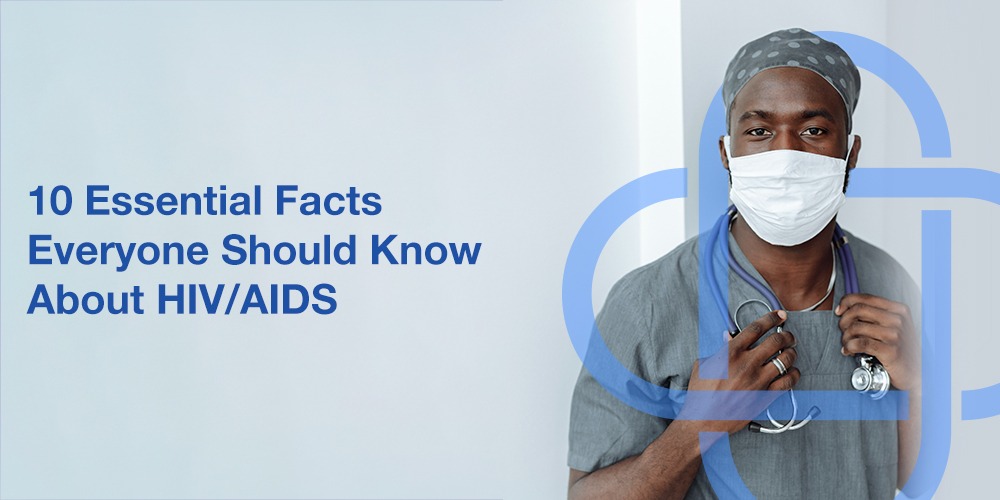HIV/AIDS remains a critical global health issue, affecting millions of people worldwide. To raise awareness and promote understanding, it’s crucial to disseminate accurate information. In this comprehensive guide, we’ll explore 10 essential facts about HIV/AIDS that everyone should know.
HIV – What is It?
HIV stands for Human Immunodeficiency Virus. It is a virus that attacks the immune system, weakening the body’s ability to fight off infections and diseases. HIV can be transmitted through unprotected sexual contact, sharing needles, or from mother to child during childbirth or breastfeeding. There is currently no cure for HIV, but with proper medical care, it can be managed effectively.
HIV vs. AIDS
HIV and AIDS are related but distinct. HIV is the virus that can lead to AIDS, which stands for Acquired Immunodeficiency Syndrome. AIDS is the final stage of HIV infection, characterized by a severely weakened immune system and the presence of opportunistic infections. Not everyone with HIV develops AIDS, especially if they receive early treatment and medical care.
Modes of Transmission
HIV is primarily transmitted through certain body fluids, including blood, semen, vaginal fluids, rectal fluids, and breast milk. It can be spread through unprotected sex, sharing needles or syringes, and from mother to child during childbirth or breastfeeding. It is not spread through casual contact like hugging, kissing, or sharing utensils.
Importance of Testing
Getting tested for HIV is crucial, as early detection allows for early intervention and treatment. Many people with HIV may not show symptoms for years, making regular testing important, especially for those at higher risk. Confidential testing is widely available at clinics, health centers, and through home testing kits.
Biocard HIV 1/2 Rapid Test Kit
Tests like Biocard HIV 1/2 Rapid Test Kit by Trivitron Healthcare is a rapid diagnostic test. It provides results relatively quickly, typically within minutes. Rapid tests are often used for quick screening and initial diagnosis, but any positive results should be confirmed with more specific laboratory-based tests.
This test is capable of detecting both HIV-1 and HIV-2 antibodies. It is important to differentiate between them as they have some differences in terms of transmission, progression, and treatment.
This test kit is an in-vitro immunochromatographic immunoassay. This means that the test is conducted outside the body (in vitro) and relies on the use of antibodies to detect the presence of HIV antibodies in the patient’s blood sample.
This kit is often used in healthcare settings, clinics, and outreach programs to identify individuals who may be infected with HIV so that they can receive appropriate counseling, care, and follow-up testing.
HIV Suppression
Antiretroviral therapy (ART) is a combination of medications used to treat HIV. When taken as prescribed, ART can suppress the virus to undetectable levels in the blood. People with undetectable viral loads cannot transmit HIV to others through sexual contact. This “Undetectable = Untransmittable” (U=U) concept is a significant development in HIV prevention.
Prevention Methods
Preventing HIV involves using various methods, including practicing safe sex by using condoms, using pre-exposure prophylaxis (PrEP) for individuals at higher risk, avoiding sharing needles or syringes, and getting tested regularly. Education and awareness are key to reducing HIV transmission.
Stigma and Discrimination
Stigma and discrimination against people living with HIV persist in many societies. These negative attitudes can deter individuals from getting tested and seeking treatment. It is essential to combat stigma through education and promoting empathy and understanding.
Global Impact
HIV/AIDS is a global pandemic that has affected millions of people worldwide. While significant progress has been made in treatment and prevention, many regions still face challenges in accessing care and resources. International efforts continue to combat the spread of HIV and support those affected.
PrEP and PEP
Pre-exposure prophylaxis (PrEP) is a medication that can be taken by individuals at higher risk of HIV to prevent infection. Post-exposure prophylaxis (PEP) is a short-term treatment that can prevent HIV infection after potential exposure, such as unprotected sex or needle sharing. Both PrEP and PEP are vital tools in HIV prevention.
Public Awareness Is a Must
While there is no cure for HIV, ongoing research and development in HIV treatment and prevention offer hope for the future. Public awareness, early testing, and access to care are crucial steps in the fight against HIV/AIDS.
By understanding these 10 key facts and promoting accurate information, we can work towards reducing HIV transmission, eradicating stigma, and improving the lives of those affected by HIV/AIDS worldwide.
Check out this informative blog post about Trivitron Healthcare’s Point of Care Testing Kits


